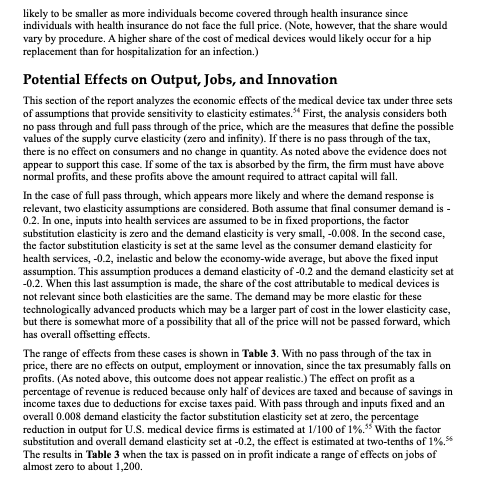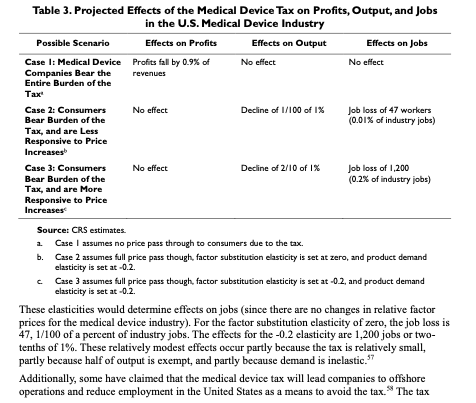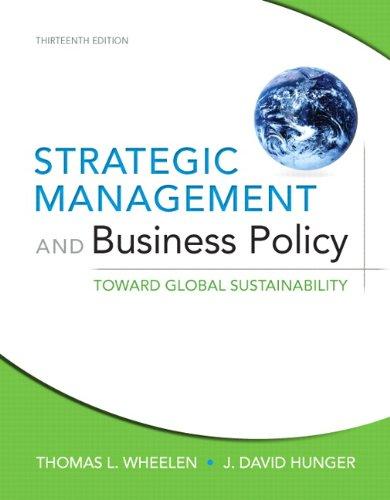4 )Can you please summarize the theoretical economic effects and Describe the "Supply and Demand Relationships" which would include
a. Why does an excise tax shift the supply curve and why upward?
b. Compare and explain the different impact on equilibrium price, quantity and the expected revenue changes (aka spending) to the industry under the different assumptions of demand elasticity, the screenshot above would help you explain to me and understand.
5) Now back to the empirical estimates and results:
a. What type of supply and demand elasticities (i.e., very elastic, inelastic, etc.) do the you suggest from the empirical evidence of this market?
b. Is more of the tax cost passed to the consumers or borne by the firms under these assumptions?
c. Summarize the 3 possible scenarios on Profits, Output & Jobs in the US Medical Device Industry, presented in the Potential Effects on Output, Jobs, and Innovation section.
6) Discussion:
a. Summarize the overall findings and possible economic effects of the tax
b. what is your opinion about the impact to
- consumers who are now "priced out" of the market for these products
- possible employment displacement in the medical device industry
company, tends to have a downward sloping marginal cost curve). A constant marginal cost assumes that firms have constant returns to scale and can produce additional amounts at the same cost. A rising marginal cost curve could also be considered, but it would not change the outcome for passing through the tax. The firm's profits (II): (5) I1 = P(Q)Q(1-1)-cQ To totally differentiate this equation and obtain the maximum profit, given t: (6) (PdQ + QdP)(1-t) - cdQ =0 This analysis considers a constant clasticity of demand function: (7) Q=AP_Ed For this function, (8) dQ/Q = -Ed (dP/P), or (9) dP = -(1/Ed)(P/Q)dQ. Substitute (9) into (6) and solve for P: (10) P = (Ed/(Ed-1))c/(1-() Compare (10) with and without the tax and the result is that Pr, the price after the tax is compared to the price without the tax, or: (11) P-P = (P/(1-(). rises by 2.35%" Because the tax is an ad valorem tax, the price rises by slightly more than P;; for a 2.3% tax, it Textbooks sometimes teach that a monopolist passes on half of the cost of an excise tax to the consumer and the same analysis would apply to a monopolistic competitor facing a downward sloping demand curve. This outcome, however, is an artifact of a linear demand curve which must intersect the x and y axis. To solve for the effect with a linear demand curve, the demand function is: (12) P = a-bQ This function can be solved by substituting (16) directly into the profit function: (13) II = (a-bQ)*(Q(1-t)) -cQ Differentiating (13), holding t constant, and finding the profit maximum, (14) (a-2bQ)(1-t)=c Solving (14) for Q and substituting it into (12) leads to the price equation: (15) P = =/2 +c/(2(1-()) With an ad valorem tax the pass through is equal to (1/2) (t(1-t))*c which passes through 1% of the portion of tax on c and thus less than half of the total tax appears in price.likely to be smaller as more individuals become covered through health insurance since individuals with health insurance do not face the full price. (Note, however, that the share would vary by procedure. A higher share of the cost of medical devices would likely occur for a hip replacement than for hospitalization for an infection.) Potential Effects on Output, Jobs, and Innovation This section of the report analyzes the economic effects of the medical device tax under three sets of assumptions that provide sensitivity to elasticity estimates." First, the analysis considers both no pass through and full pass through of the price, which are the measures that define the possible values of the supply curve elasticity (zero and infinity). If there is no pass through of the tax, there is no effect on consumers and no change in quantity. As noted above the evidence does not appear to support this case. If some of the tax is absorbed by the firm, the firm must have above normal profits, and these profits above the amount required to attract capital will fall In the case of full pass through, which appears more likely and where the demand response is relevant, two elasticity assumptions are considered. Both assume that final consumer demand is - 0.2. In one, inputs into health services are assumed to be in fixed proportions, the factor substitution elasticity is zero and the demand elasticity is very small, -0.008. In the second case, the factor substitution elasticity is set at the same level as the consumer demand elasticity for health services, -0.2, inelastic and below the economy-wide average, but above the fixed input assumption. This assumption produces a demand elasticity of -0.2 and the demand elasticity set at -0.2. When this last assumption is made, the share of the cost attributable to medical devices is not relevant since both clasticities are the same. The demand may be more clastic for these technologically advanced products which may be a larger part of cost in the lower elasticity case, but there is somewhat more of a possibility that all of the price will not be passed forward, which has overall offsetting effects. The range of effects from these cases is shown in Table 3. With no pass through of the tax in price, there are no effects on output, employment or innovation, since the tax presumably falls on profits. (As noted above, this outcome does not appear realistic.) The effect on profit as a percentage of revenue is reduced because only half of devices are taxed and because of savings in income taxes due to deductions for excise taxes paid. With pass through and inputs fixed and an overall 0.008 demand elasticity the factor substitution elasticity set at zero, the percentage reduction in output for U.S. medical device firms is estimated at 1/100 of 1%."With the factor substitution and overall demand elasticity set at -0.2, the effect is estimated at two-tenths of 1%. The results in Table 3 when the tax is passed on in profit indicate a range of effects on jobs of almost zero to about 1,200.Table 3. Projected Effects of the Medical Device Tax on Profits, Output, and Jobs in the U.S. Medical Device Industry Possible Scenario Effects on Profits Effects on Output Effects on Jobs Case It Medical Device Profits fall by 0.9% of No effect No effect Companies Bear the revenues Entire Burden of the Tax" Case 2: Consumers No effect Decline of 1/100 of 1% Job loss of 47 workers Bear Burden of the (0.0 1% of industry jobs) Tax, and are Less Responsive to Price Increases" Case 3: Consumers No effect Decline of 2/10 of 1% Job loss of 1,200 Bear Burden of the (0.2% of industry jobs) Tax, and are More Responsive to Price Increases' Source: CRS estimates Case I assumes no price pass through to consumers due to the tax. b. Case 2 assumes full price pass though, factor substitution elasticity is set at zero, and product demand elasticity is set at -0.2. c Case 3 assumes full price pass though, factor substitution elasticity is set at -0.2, and product demand elasticity is set at -0.2. These elasticities would determine effects on jobs (since there are no changes in relative factor prices for the medical device industry). For the factor substitution elasticity of zero, the job loss is 47, 1/100 of a percent of industry jobs. The effects for the -0.2 elasticity are 1,200 jobs or two- tenths of 1%. These relatively modest effects occur partly because the tax is relatively small, partly because half of output is exempt, and partly because demand is inelastic." Additionally, some have claimed that the medical device tax will lead companies to offshore operations and reduce employment in the United States as a means to avoid the tax. The tax









